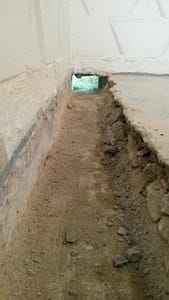The Buzz on Best Basement Waterproofing
Table of ContentsThe Definitive Guide for Best Basement WaterproofingLittle Known Facts About Best Basement Waterproofing.The Definitive Guide for Best Basement WaterproofingSome Known Incorrect Statements About Best Basement Waterproofing The 20-Second Trick For Best Basement Waterproofing
uses excavation techniques toward the base of the framework's foundation. entails eliminating dampness after it has actually gotten in the basement. AdvantaClean's experienced specialists and professionals will locate the water resource. If wall or slab fractures exist, we will certainly infuse polyurethane and epoxies right into the cracks and secure the concession, avoiding further wetness from getting in.If there's condensation on the exterior of the aluminum foil, you have high humidity in your basement. If the foil has condensation on the within surface (following to the wall), the soil around your home might be naturally damp from a high water table or bad soil drainage.
You can waterproof just your indoor wall surfaces, which may address the trouble. Once they dry, they stick completely to concrete and masonry wall surfaces.
The 3-Minute Rule for Best Basement Waterproofing
Concrete water-proof finishes can't be used to formerly repainted surface areas; examine the tag. Known as densifiers, they are suitable just for walls that haven't been painted or sealed.
You comb, roll, or spray it on much more heavily one gallon covers simply 75 square feet, not the 300 square feet common with standard paint. Waterproof paint is great for DIY application. You can apply it over repainted surfaces, and paint over it once it's treated (one gallon costs $37).
It can set you back $10,000 to $15,000, depending on the work needed. Exterior waterproofing entails excavating all around the residence to the full deepness of the foundation wall surfaces, after that mounting a water resistant covering or membrane covered by drain panels.
A cellar without waterproofing is kind of like that. Your cellar does not desire to go via a rainstorm without proper security just as much as you do not want to.
The 10-Second Trick For Best Basement Waterproofing
Yet if you have actually done your study, you would certainly recognize there are 2 sorts of waterproofing: inside and exterior. It can get confusing what they both mean, which one's a far better financial investment, and what will actually keep the water out. Don't stress, we placed with each other read the article this blog site to easily define both techniques for you and go over the advantages and disadvantages of each.
Outside waterproofing is a waterproofing approach that includes securing your home from the outside. It's kind of like a moat around a castle. It entails digging a trench around your whole home down to the structure (regarding 8 to 10 feet down). The foundation wall surfaces are after that cleansed, sealed, and covered with a water resistant membrane layer or sealer.

Best Basement Waterproofing for Beginners
It's a more involved procedure that requires digging up your lawn, which is costly and time-consuming. Outside waterproofing entails removing every little thing bordering the home, including verandas, driveways, sidewalks, landscape design, air conditioning devices, decks, and so on. If any of the work was done improperly and water is still entering your cellar, there isn't official source much you can do to deal with or fix it.
Interior cellar waterproofing entails waterproofing from the within. Any kind of water that leakages into your basement is redirected before it touches your flooring.
It's an efficient technique to waterproof your basement - Best Basement Waterproofing. The drawback of interior cellar waterproofing mostly concerns the installation process. This technique calls for saved items, furniture, and integrated shelving or cabinets to be moved from touching the basement walls. And throughout installation, your basement can't be used. The most significant distinction in between the 2 approaches is this: Exterior waterproofing is a preventative solution and interior waterproofing is a restorative option.
Getting My Best Basement Waterproofing To Work
Finally, outside and indoor basement waterproofing are both efficient techniques of securing your home from water damage. Outside waterproofing creates a barrier that protects against water from entering your home, while interior waterproofing redirects water that does enter your home. And it is necessary to note that exterior waterproofing is a costly and disruptive installation process when contrasted to interior waterproofing.
Whichever approach you select, make sure you select a reputable and trustworthy specialist for the task. Both approaches need experienced employees to manage the job. If you have any kind of questions about basement waterproofing, please connect to us. And if you're in our solution area and have water in your basement, call us for a totally free, no-obligation home evaluation.
You can submit our kind right here, begin a chat in the bottom right-hand edge, or call us at 1-800-827-0702.